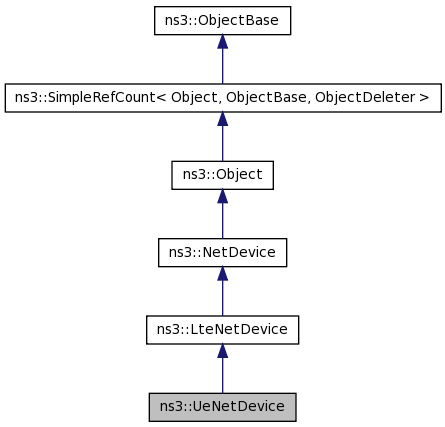ns3::UeNetDevice Class Reference
#include <ue-net-device.h>


Public Member Functions | |
| UeNetDevice (Ptr< Node > node, Ptr< LtePhy > phy) | |
| Create an UE net device. | |
| UeNetDevice (Ptr< Node > node, Ptr< LtePhy > phy, Ptr< EnbNetDevice > targetEnb) | |
| Create an UE net device. | |
| virtual void | DoDispose () |
| void | SetMacEntity (Ptr< UeMacEntity > m) |
| Set the MAC entity. | |
| Ptr< UeMacEntity > | GetMacEntity (void) |
| Get the MAC entity. | |
| void | InitUeNetDevice (void) |
| Initialize the UE. | |
| void | Start (void) |
| This method is called as soon as the net device is created. It can be used to start some functionalities of the considered device. For example, for the eNB device it starts the schedule of LTE Frames. | |
| void | Stop (void) |
| void | SetTargetEnb (Ptr< EnbNetDevice > enb) |
| Set the targer eNB where the UE is registered. | |
| Ptr< EnbNetDevice > | GetTargetEnb (void) |
| Get the targer eNB where the UE is registered. | |
| void | StartTransmission (void) |
| Start packet transmission. This functipon will called when a PDCCH messages is received According to the allocated resources in the uplink the UE create a packet burst and send it to the phy layer. | |
| bool | SendPacket (Ptr< PacketBurst > p) |
| Send packet/packets to the physical layer. | |
Static Public Member Functions | |
| static TypeId | GetTypeId (void) |
| This method returns the TypeId associated to ns3::UeNetDevice. | |
Detailed Description
The UeNetDevice class implements the UE net device
Constructor & Destructor Documentation
Create an UE net device.
- Parameters:
-
node phy
| ns3::UeNetDevice::UeNetDevice | ( | Ptr< Node > | node, | |
| Ptr< LtePhy > | phy, | |||
| Ptr< EnbNetDevice > | targetEnb | |||
| ) |
Create an UE net device.
- Parameters:
-
node phy targetEnb the enb where the UE is registered
Member Function Documentation
| virtual void ns3::UeNetDevice::DoDispose | ( | ) | [virtual] |
This method is called by Object::Dispose or by the object's destructor, whichever comes first.
Subclasses are expected to implement their real destruction code in an overriden version of this method and chain up to their parent's implementation once they are done. i.e., for simplicity, the destructor of every subclass should be empty and its content should be moved to the associated DoDispose method.
It is safe to call GetObject from within this method.
Reimplemented from ns3::LteNetDevice.
| Ptr<UeMacEntity> ns3::UeNetDevice::GetMacEntity | ( | void | ) |
Get the MAC entity.
- Returns:
- the pointer to the MAC entity
| Ptr<EnbNetDevice> ns3::UeNetDevice::GetTargetEnb | ( | void | ) |
Get the targer eNB where the UE is registered.
- Returns:
- the pointer to the enb
| static TypeId ns3::UeNetDevice::GetTypeId | ( | void | ) | [static] |
This method returns the TypeId associated to ns3::UeNetDevice.
This object is accessible through the following paths with Config::Set and Config::Connect:
- /NodeList/[i]/DeviceList/[i]/$ns3::AlohaNoackNetDevice/Phy/$ns3::LteNetDevice/$ns3::UeNetDevice
- /NodeList/[i]/DeviceList/[i]/$ns3::AlohaNoackNetDevice/Phy/$ns3::UeNetDevice
- /NodeList/[i]/DeviceList/[i]/$ns3::BaseStationNetDevice/BsIpcsPacketClassifier/$ns3::LteNetDevice/$ns3::UeNetDevice
- /NodeList/[i]/DeviceList/[i]/$ns3::BaseStationNetDevice/BsIpcsPacketClassifier/$ns3::UeNetDevice
- /NodeList/[i]/DeviceList/[i]/$ns3::BaseStationNetDevice/LinkManager/$ns3::LteNetDevice/$ns3::UeNetDevice
- /NodeList/[i]/DeviceList/[i]/$ns3::BaseStationNetDevice/LinkManager/$ns3::UeNetDevice
- /NodeList/[i]/DeviceList/[i]/$ns3::BaseStationNetDevice/SSManager/$ns3::LteNetDevice/$ns3::UeNetDevice
- /NodeList/[i]/DeviceList/[i]/$ns3::BaseStationNetDevice/SSManager/$ns3::UeNetDevice
- /NodeList/[i]/DeviceList/[i]/$ns3::BaseStationNetDevice/ServiceFlowManager/$ns3::LteNetDevice/$ns3::UeNetDevice
- /NodeList/[i]/DeviceList/[i]/$ns3::BaseStationNetDevice/ServiceFlowManager/$ns3::UeNetDevice
- /NodeList/[i]/DeviceList/[i]/$ns3::LteNetDevice/$ns3::UeNetDevice
- /NodeList/[i]/DeviceList/[i]/$ns3::NonCommunicatingNetDevice/Phy/$ns3::LteNetDevice/$ns3::UeNetDevice
- /NodeList/[i]/DeviceList/[i]/$ns3::NonCommunicatingNetDevice/Phy/$ns3::UeNetDevice
- /NodeList/[i]/DeviceList/[i]/$ns3::SubscriberStationNetDevice/Classifier/$ns3::LteNetDevice/$ns3::UeNetDevice
- /NodeList/[i]/DeviceList/[i]/$ns3::SubscriberStationNetDevice/Classifier/$ns3::UeNetDevice
- /NodeList/[i]/DeviceList/[i]/$ns3::SubscriberStationNetDevice/LinkManager/$ns3::LteNetDevice/$ns3::UeNetDevice
- /NodeList/[i]/DeviceList/[i]/$ns3::SubscriberStationNetDevice/LinkManager/$ns3::UeNetDevice
- /NodeList/[i]/DeviceList/[i]/$ns3::SubscriberStationNetDevice/SSScheduler/$ns3::LteNetDevice/$ns3::UeNetDevice
- /NodeList/[i]/DeviceList/[i]/$ns3::SubscriberStationNetDevice/SSScheduler/$ns3::UeNetDevice
- /NodeList/[i]/DeviceList/[i]/$ns3::UanNetDevice/Channel/NoiseModel/$ns3::LteNetDevice/$ns3::UeNetDevice
- /NodeList/[i]/DeviceList/[i]/$ns3::UanNetDevice/Channel/NoiseModel/$ns3::UeNetDevice
- /NodeList/[i]/DeviceList/[i]/$ns3::UanNetDevice/Channel/PropagationModel/$ns3::LteNetDevice/$ns3::UeNetDevice
- /NodeList/[i]/DeviceList/[i]/$ns3::UanNetDevice/Channel/PropagationModel/$ns3::UeNetDevice
- /NodeList/[i]/DeviceList/[i]/$ns3::UanNetDevice/Mac/$ns3::LteNetDevice/$ns3::UeNetDevice
- /NodeList/[i]/DeviceList/[i]/$ns3::UanNetDevice/Mac/$ns3::UeNetDevice
- /NodeList/[i]/DeviceList/[i]/$ns3::UanNetDevice/Phy/$ns3::LteNetDevice/$ns3::UeNetDevice
- /NodeList/[i]/DeviceList/[i]/$ns3::UanNetDevice/Phy/$ns3::UeNetDevice
- /NodeList/[i]/DeviceList/[i]/$ns3::UanNetDevice/Transducer/$ns3::LteNetDevice/$ns3::UeNetDevice
- /NodeList/[i]/DeviceList/[i]/$ns3::UanNetDevice/Transducer/$ns3::UeNetDevice
- /NodeList/[i]/DeviceList/[i]/$ns3::UeNetDevice
- /NodeList/[i]/DeviceList/[i]/$ns3::WimaxNetDevice/$ns3::BaseStationNetDevice/BsIpcsPacketClassifier/$ns3::LteNetDevice/$ns3::UeNetDevice
- /NodeList/[i]/DeviceList/[i]/$ns3::WimaxNetDevice/$ns3::BaseStationNetDevice/BsIpcsPacketClassifier/$ns3::UeNetDevice
- /NodeList/[i]/DeviceList/[i]/$ns3::WimaxNetDevice/$ns3::BaseStationNetDevice/LinkManager/$ns3::LteNetDevice/$ns3::UeNetDevice
- /NodeList/[i]/DeviceList/[i]/$ns3::WimaxNetDevice/$ns3::BaseStationNetDevice/LinkManager/$ns3::UeNetDevice
- /NodeList/[i]/DeviceList/[i]/$ns3::WimaxNetDevice/$ns3::BaseStationNetDevice/SSManager/$ns3::LteNetDevice/$ns3::UeNetDevice
- /NodeList/[i]/DeviceList/[i]/$ns3::WimaxNetDevice/$ns3::BaseStationNetDevice/SSManager/$ns3::UeNetDevice
- /NodeList/[i]/DeviceList/[i]/$ns3::WimaxNetDevice/$ns3::BaseStationNetDevice/ServiceFlowManager/$ns3::LteNetDevice/$ns3::UeNetDevice
- /NodeList/[i]/DeviceList/[i]/$ns3::WimaxNetDevice/$ns3::BaseStationNetDevice/ServiceFlowManager/$ns3::UeNetDevice
- /NodeList/[i]/DeviceList/[i]/$ns3::WimaxNetDevice/$ns3::SubscriberStationNetDevice/Classifier/$ns3::LteNetDevice/$ns3::UeNetDevice
- /NodeList/[i]/DeviceList/[i]/$ns3::WimaxNetDevice/$ns3::SubscriberStationNetDevice/Classifier/$ns3::UeNetDevice
- /NodeList/[i]/DeviceList/[i]/$ns3::WimaxNetDevice/$ns3::SubscriberStationNetDevice/LinkManager/$ns3::LteNetDevice/$ns3::UeNetDevice
- /NodeList/[i]/DeviceList/[i]/$ns3::WimaxNetDevice/$ns3::SubscriberStationNetDevice/LinkManager/$ns3::UeNetDevice
- /NodeList/[i]/DeviceList/[i]/$ns3::WimaxNetDevice/$ns3::SubscriberStationNetDevice/SSScheduler/$ns3::LteNetDevice/$ns3::UeNetDevice
- /NodeList/[i]/DeviceList/[i]/$ns3::WimaxNetDevice/$ns3::SubscriberStationNetDevice/SSScheduler/$ns3::UeNetDevice
- /NodeList/[i]/DeviceList/[i]/$ns3::WimaxNetDevice/BandwidthManager/$ns3::LteNetDevice/$ns3::UeNetDevice
- /NodeList/[i]/DeviceList/[i]/$ns3::WimaxNetDevice/BandwidthManager/$ns3::UeNetDevice
- /NodeList/[i]/DeviceList/[i]/$ns3::WimaxNetDevice/BurstProfileManager/$ns3::LteNetDevice/$ns3::UeNetDevice
- /NodeList/[i]/DeviceList/[i]/$ns3::WimaxNetDevice/BurstProfileManager/$ns3::UeNetDevice
- /NodeList/[i]/DeviceList/[i]/$ns3::WimaxNetDevice/Channel/$ns3::UanChannel/NoiseModel/$ns3::LteNetDevice/$ns3::UeNetDevice
- /NodeList/[i]/DeviceList/[i]/$ns3::WimaxNetDevice/Channel/$ns3::UanChannel/NoiseModel/$ns3::UeNetDevice
- /NodeList/[i]/DeviceList/[i]/$ns3::WimaxNetDevice/Channel/$ns3::UanChannel/PropagationModel/$ns3::LteNetDevice/$ns3::UeNetDevice
- /NodeList/[i]/DeviceList/[i]/$ns3::WimaxNetDevice/Channel/$ns3::UanChannel/PropagationModel/$ns3::UeNetDevice
- /NodeList/[i]/DeviceList/[i]/$ns3::WimaxNetDevice/ConnectionManager/$ns3::LteNetDevice/$ns3::UeNetDevice
- /NodeList/[i]/DeviceList/[i]/$ns3::WimaxNetDevice/ConnectionManager/$ns3::UeNetDevice
- /NodeList/[i]/DeviceList/[i]/$ns3::WimaxNetDevice/Phy/Channel/$ns3::UanChannel/NoiseModel/$ns3::LteNetDevice/$ns3::UeNetDevice
- /NodeList/[i]/DeviceList/[i]/$ns3::WimaxNetDevice/Phy/Channel/$ns3::UanChannel/NoiseModel/$ns3::UeNetDevice
- /NodeList/[i]/DeviceList/[i]/$ns3::WimaxNetDevice/Phy/Channel/$ns3::UanChannel/PropagationModel/$ns3::LteNetDevice/$ns3::UeNetDevice
- /NodeList/[i]/DeviceList/[i]/$ns3::WimaxNetDevice/Phy/Channel/$ns3::UanChannel/PropagationModel/$ns3::UeNetDevice
No Attributes defined for this type.
Attributes defined in parent class ns3::LteNetDevice:
-
Mtu: The MAC-level Maximum Transmission Unit
- Set with class: ns3::UintegerValue
- Underlying type: uint16_t 0:1500
- Initial value: 1500
- Flags: construct write read
-
Phy: The PHY layer attached to this device.
- Set with class: ns3::PointerValue
- Underlying type: ns3::Ptr< ns3::LtePhy >
- Initial value: 0
- Flags: construct write read
No TraceSources defined for this type.
Reimplemented from ns3::LteNetDevice.
| bool ns3::UeNetDevice::SendPacket | ( | Ptr< PacketBurst > | p | ) | [virtual] |
Send packet/packets to the physical layer.
- Parameters:
-
p packet/packets to be sent
Implements ns3::LteNetDevice.
| void ns3::UeNetDevice::SetMacEntity | ( | Ptr< UeMacEntity > | m | ) |
Set the MAC entity.
- Parameters:
-
m the MAC entity
| void ns3::UeNetDevice::SetTargetEnb | ( | Ptr< EnbNetDevice > | enb | ) |
Set the targer eNB where the UE is registered.
- Parameters:
-
enb
| void ns3::UeNetDevice::Stop | ( | void | ) | [virtual] |
Ends the run of this device
Implements ns3::LteNetDevice.
The documentation for this class was generated from the following files:
- src/devices/lte/model/ue-net-device.h
- doc/introspected-doxygen.h
 1.6.1
1.6.1